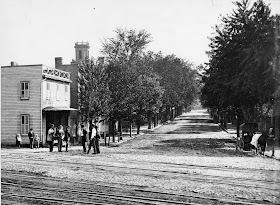"What William Brady, the well known photographer of Lincoln, was to Civil War history, Henry Tripp was to the record of Schenectady."
- From Schenectady Gazette, April 23, 1959
 |
| Henry Tripp, ca. 1870. From Grems- Doolittle Library Photograph Collection. |
Tripp was born in Schenectady in 1828. He left home to live and work in many different locations, including Ontario and Virginia. During the late 1840s, he was working as a plate photographer in Woodstock, Ontario. In the early 1850's, Henry and his brother Charles established the first oil company formed in North America. The company explored for asphalt beds and oil and salt springs. Lack of capital and high transportation costs forced the business to fold by the late 1850s, and the Tripp brothers sold their land holdings in Canada. Tripp, who moved back and forth between Woodstock, Ontario, and Petersburg, Virginia, moved back to the area sometime during the 1860s.
The first listing for Henry Tripp in the Schenectady city directory appears in the 1868-1869 directory. "Henry Tripp, photographer, appears," the editors of the the "brief mentions" section of the Evening Star newspaper write on April 30, 1869. "His rooms are at No. 81 State Street. His pictures can't be excelled." To take his outdoor photographs, Tripp used a horse-drawn portable darkroom in which he would develop glass plate negatives. Using what was known as a collodion or "wet plate" process, Tripp had to coat, sensitize, expose and develop his glass plate negatives within about ten to fifteen minutes, before the plate dried.
 |
| Print of Tripp negative of First Reformed Church. From Grems-Doolittle Library Photograph Collection. This image might be the same image advertised below in the Evening Star in 1868. |
 |
| Notice from July 6, 1868 Evening Star advertising sale of prints of Tripp's photograph of the First Reformed Church. Image obtained via www.fultonhistory.com. |
Tripp took photographs all over Schenectady and its environs. Historian Larry Hart writes the Tripp "roamed far and wide with his horsedrawn darkroom - across the old covered bridge to Scotia and Glenville, the turnpikes to Amsterdam and Albany and along many of Schenectady's principal streets, including Dock Street along the Erie Canal. They show the old taverns, the cobblestone streets, rutted wagon roads and pose for the three- to six-second exposures." Tripp found ready buyers among area residents, selling photos for around two dollars apiece. He also exhibited his work locally, including an exhibition at the Schenectady County Agricultural Association fair in 1868.
 |
| Photograph by Tripp of the Edward Rosa House on Union Street. From Larry Hart Collection. |
Tripp disappears from the Schenectady city directory in 1893. By 1900, he was living in Lynn, Massachusetts, where he died in 1908. He was returned to Schenectady for burial in the First Presbyterian Church cemetery.



I have one of his photographs. Seven dollars is a steal, he was an awesome guy. RIP to a real one.
ReplyDelete